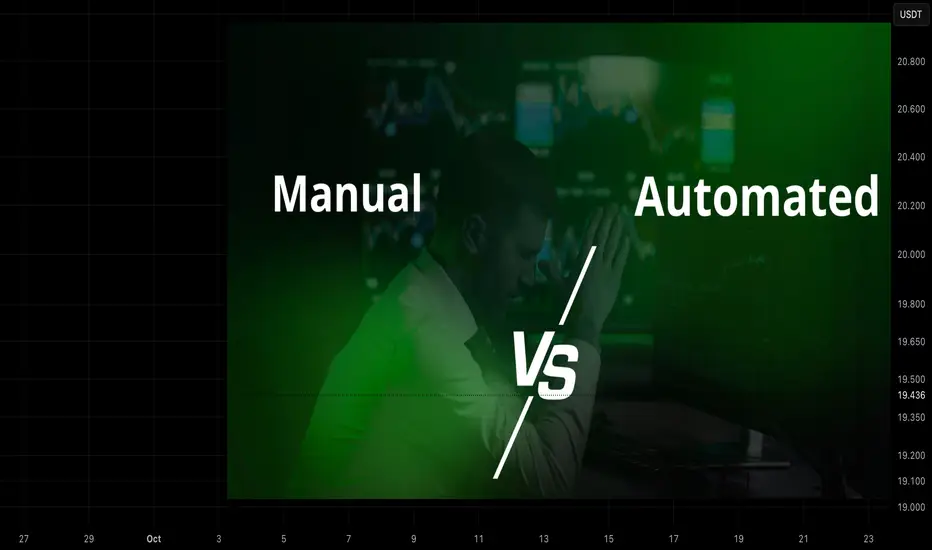Most traders start out manually, staring at charts for hours, hunting for that perfect setup, trying to outsmart the market.
It feels alive. You’re in control.
But after a while, you realize something brutal:
the real opponent isn’t the market, it’s you.
Fear, greed, hesitation, fatigue. The emotions that ruin good trades. That’s when automation steps in.

Manual Trading
Manual trading builds skill, but it also exposes every weakness you’ve got.
If this sounds familiar, you’re not alone:
Manual trading gives flexibility, sure.
But it also gives you the freedom to sabotage your own plan.
Automated Trading
Benefits
Consistency: trades follow predefined rules, eliminating impulsive deviations from the plan.
Scale: automation handles higher frequency and 24/7 market coverage beyond human capacity.
Speed and precision: orders execute with lower latency and exact risk parameters.
Backtest + deploy: strategies validated historically can be deployed reliably across multiple markets.
Operational leverage: frees human time for strategy development, risk oversight, and portfolio decisions.
Disadvantages and risks
Model risk: historical backtests do not guarantee future performance; edge can decay.
Overfitting and brittle rules: overly specific parameters may break under regime changes.
Misaligned incentives: automated systems execute mechanically; they cannot judge rare macro events or qualitative news.
Monitoring burden: automation reduces manual trading work but increases need for robust monitoring, alerts, and contingency plans beforehand.

⚔️ Two Traders, One Market
Here’s the truth: two traders can run the same strategy and get completely different results.
Trader A trades manually, emotional, inconsistent.
Trader B runs automation, same logic, perfect execution.
Same system. Different outcome.
Guess which one ends up consistent?
It feels alive. You’re in control.
But after a while, you realize something brutal:
the real opponent isn’t the market, it’s you.
Fear, greed, hesitation, fatigue. The emotions that ruin good trades. That’s when automation steps in.
Manual Trading
Manual trading builds skill, but it also exposes every weakness you’ve got.
If this sounds familiar, you’re not alone:
- Entering late because you hesitated.
- Moving your stop loss “just one more time.”
- Doubling down after a loss.
- Missing setups because you needed sleep.
Manual trading gives flexibility, sure.
But it also gives you the freedom to sabotage your own plan.
Automated Trading
Benefits
Consistency: trades follow predefined rules, eliminating impulsive deviations from the plan.
Scale: automation handles higher frequency and 24/7 market coverage beyond human capacity.
Speed and precision: orders execute with lower latency and exact risk parameters.
Backtest + deploy: strategies validated historically can be deployed reliably across multiple markets.
Operational leverage: frees human time for strategy development, risk oversight, and portfolio decisions.
Disadvantages and risks
Model risk: historical backtests do not guarantee future performance; edge can decay.
Overfitting and brittle rules: overly specific parameters may break under regime changes.
Misaligned incentives: automated systems execute mechanically; they cannot judge rare macro events or qualitative news.
Monitoring burden: automation reduces manual trading work but increases need for robust monitoring, alerts, and contingency plans beforehand.
⚔️ Two Traders, One Market
Here’s the truth: two traders can run the same strategy and get completely different results.
Trader A trades manually, emotional, inconsistent.
Trader B runs automation, same logic, perfect execution.
Same system. Different outcome.
Guess which one ends up consistent?
May the Green Spirit be with You ❇️💚
إخلاء المسؤولية
لا يُقصد بالمعلومات والمنشورات أن تكون، أو تشكل، أي نصيحة مالية أو استثمارية أو تجارية أو أنواع أخرى من النصائح أو التوصيات المقدمة أو المعتمدة من TradingView. اقرأ المزيد في شروط الاستخدام.
May the Green Spirit be with You ❇️💚
إخلاء المسؤولية
لا يُقصد بالمعلومات والمنشورات أن تكون، أو تشكل، أي نصيحة مالية أو استثمارية أو تجارية أو أنواع أخرى من النصائح أو التوصيات المقدمة أو المعتمدة من TradingView. اقرأ المزيد في شروط الاستخدام.
